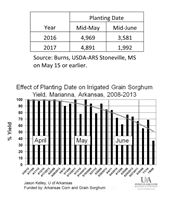Double Cropping And Late-Planted Grain Sorghum
BRENT BEAN
LUBBOCK, TEXAS
Growers often use grain sorghum as a double crop – behind wheat or a failed spring crop – because sorghum has a relatively low input cost and can produce good yields with favorable late season weather conditions. However, grain sorghum yields are much less consistent or predictable with late planting dates.
Researchers have conducted many planting date studies over the years where the results have been strongly influenced by local conditions during the time frame of the trial. Growers can learn a few general underlying principles from these studies.
In a 2017 trial conducted by the USDA-ARS at Stoneville, Mississippi, researchers found that delaying planting from mid-May to mid-June resulted in a yield reduction of 59 percent compared to only 28 percent in 2016.
In a six-year planting date study at Marianna, Arkansas, researchers found that sorghum planted after June 1 consistently yielded 80 percent less than sorghum planted on May 15 or earlier.

Though every year is different, growers can expect lower yields once planting is delayed 30 to 45 days past the optimum planting date in most regions. Heat stress is likely one of the primary reasons for lower yields with late-planted sorghum. High temperatures that occur from 10 days before heading to 10 days after flowering will have a detrimental effect on yield. Yields from late planting are expected to be higher in years when adequate rainfall and cooler temperatures occur in July and August.
Insects are more likely to be an issue with late-planted sorghum. Midge has long been a pest in the mid-South, and early planting is one of the integrated pest management strategies for controlling midge. With late planting, growers should apply an insecticide for midge control during sorghum flowering, which typically lasts for seven days. Sugarcane aphids are likely to occur earlier in the growth cycle of the sorghum plant – at a time when they can cause severe reduction in yield. For aphids, growers should scout fields early and be prepared to apply an insecticide as soon as threshold levels are reached. State extension entomologists have excellent resources available for managing insects in sorghum.
When planting sorghum after wheat harvest where heavy wheat stubble is present, growers should increase the sorghum seeding rate by 20 percent. In addition, when applying herbicides, growers should use plenty of water to provide better coverage on emerged weeds and aid in getting pre-emergence herbicides to the soil. ∆
BRENT BEAN: USCP Agronomist
